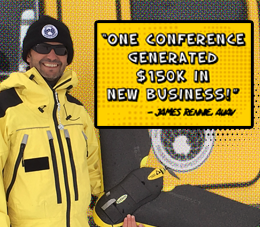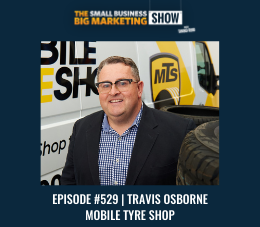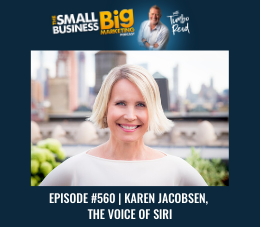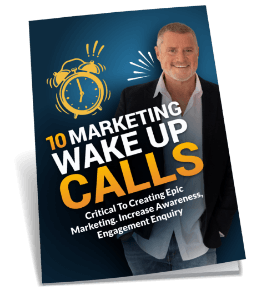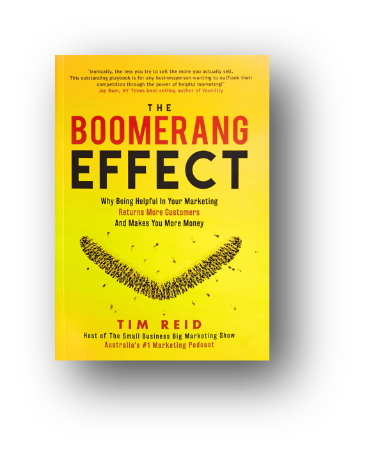Does public speaking freak you out? I’m guessing that’s a YES! But what if you spoke to a group of your ideal clients, and it generated a cool $150,000 in new business, and got you a full-page article in the Wall Street Journal? Would public speaking still freak you out? I’m guessing not! Today’s guest owns a Drone business, is not a professional public speaker, yet has made it his #1 marketing strategy. And it’s working a treat!
“In such a new industry we recognised the need to be seen as the leaders and set out on the speaking circuit as our primary form of direct marketing. With 27 conferences in 2017 we avoid the drone shows but have spoken on landfills, forestry, power infrastructure, agriculture, mining, quarrying, renewable energy and many more. ”
– James Rennie,
AUAV
There’s loads more tips and insights just like this that will help you build that beautiful business of yours into the empire it deserves to be. Hit the PLAY button above to listen now, or subscribe free to hear the full interview. You’ll also find the full interview transcription below.
If you have questions about speaking at conferences then you’ll get this answers in this interview, including:
- Why should business owners speak at conferences?
- Why does speaking at conferences position you as an industry authority?
- How do you decide what conferences to speak at?
- How do you get accepted as a speaker at an industry conference?
- How do you become a proficient public speaker?
- What else do you need to do to make a conference generate a return?
- Plus plenty more …
A little more about today’s guest:
James Rennie, is the co-founder of high tech drone business Australian Unmanned Aerial Vehicles – and, whilst he’s not a professional speaker, he makes a motza from speaking at conferences.
You see, five years ago, he and his business partner Andrew, founded one of the first drone service businesses in Australia.
At the time, their marketing was focused around explaining what a drone was, and what could be done with one.
They then realised that as pioneers in a new industry they needed to be seen as the authorities, and set out on the conference speaking circuit as their primary form of direct marketing.
They spoke at 27 conferences last year for industries as diverse as landfill, forestry, power, refrigeration … just to name a few.
So have your pen and paper at the ready, as James explains exactly how he does it, and what it’s lead to.
Here’s what caught my attention from my chat with AUAV’s James Rennie:
- I think James’s conference speaking strategy is simple and brilliant … and I’d love you to adopt it. So here’s my challenge to you … go ahead and write a script for a 15-minute presentation that you know would be of benefit to your prospects. Then, go ahead and create a slide deck that supports your script. Practice it 20 times. Then find a conference that you’d love to speak at and get a spot on the stage. Scary, huh?!
- I love how James is also embedding himself in the conferences …. Sometimes taking an expo booth, other times sponsoring items like the memory stick. Speaking from stage is one thing, but being part of the overall conference experience is best practice.
- I loved the Dodgy Operator of the Month idea that he includes in each newsletter. Sometimes we can forget that as business owners and marketers we must entertain as well as educate and be helpful.
James Rennie Interview Transcription
James
I started off as a relatively small kid flying drone’s way back when and then left it alone for a long time and then saw an opportunity about five and a half years ago.
Tim
To turn your toy obsession into a business. How long ago it may I thought drones had only been around for I don’t know and I was going to say five years. Clearly not.
James
Pretty much. There was a lot of experimentation going along. Prior to that, but in terms of commercialisation five years ago is kind of when it started to kick off. So, I think there were about 20 to 30 companies in Australia specialising in drones at that time.
Tim
Aha. Well I know the competition has heated up. We’ll talk about that in a minute but by trade I understand you’re a natural resource scientist who’s worked for government, worked for big business. So, what made you decided to go out and start your own business in drone technology.
James
It really was around data’s. So, looking at the type of data that my clients were using, sort of back then, so aerial photography aerial surveys, LADAR, and those sorts of things I could see that drones could fulfil basically the same service for my existing clients. So, I had a bit of a leg up in terms of having a client base there ready to go with the new service.
Tim
Were you sick of corporate?
James
I wasn’t sick of corporate. I’d just been doing roughly the same thing for about 17 years and I just thought that it was time for a change and time for a new thing.
Tim
Had you run a small business before or was this the first foray into it?
James
No this is the first foray. I’d worked within large businesses and small to medium businesses. But this is my first jump into doing one thing.
Tim
How that goes?
James
It’s all or nothing. So, I went into it basically with a view that I would throw absolutely everything into it and sort of burn all the bridges behind me. It was an entertaining exercise. It had many many ups and downs let’s put it that way.
Tim
Let me just understand that, I mean you pretty much said no parachute here, we’re going to jump because you do have a partner in Andrew and we’re all in. This is not something we’re going to test the waters and then if it fails crawl back to our comfy corporate suites. We’re just all in this.
James
This was 100 percent all in. It had to work. So, I think, as you say and not taking the parachute with you. It gives you focus. So, you don’t want to deviate from your path.
Tim
It’s interesting. I’ve spoken and read a few times about the idea of not having a plan B. In fact, you often hear it on that show Shark Tank where there’s no Plan B. You’re all in and it kind of gives you a very different perspective as to how you approach the business.
James
Yeah absolutely. For the first few years, I started every week, with a very focused, where’s my revenue for this week coming from. So, I’d set myself a target and that target was an ongoing rolling target. And every week I would start the week with I need to make the revenue this week. Where’s it going to come from this week and if it wasn’t coming from somewhere I knew I had work to do.
Tim
It’s very different approach to imagine what you had when we’re working for government or corporate which was you had a job to do. Sure, you had to bring in revenue but you were really there to manage clients and whatever you were doing in the corporate role so must have been a very different mind shift you have to then worry about bills and money and cash flow and all those horrible things.
James
Well the thing is working in a large business then jumping into a small business. There is a whole world of hidden backroom things that are undertaken in large business that you are not familiar with them from a reporting perspective but having to actually engage and do them every day and that was a bit of a learning experience as well. That was quite rewarding actually it’s good.
Tim
Now I fell into the trap when you first approached me of going Oh this is a drone photography business and when I said that to you, you very quickly said we are not a drone photography business what do you say to people when they ask what you do.
James
My first thing is we respond to it. We don’t do real estate. So, which is pretty much what everyone says Oh you’re doing photography. You must be doing real estate photography. No. We did one real estate photography job once and that’s over five years. So, we do data and we’re basically a data business that happens to fly drones to collect our data.
Tim
So, give an example.
James
Drone surveys. So, we can 3D model sites. We do a lot of work with the landfill sector. Landfills, quarries, mines, land developers. We can fly sites and develop a 3D model of the terrain. Generate contours, work out compaction rates, it’s really about that getting an insight into a property and using drone data as an effective and cheap tool to collect that data.
Tim
Okay that’s so vastly different to going up and taking a nice shot of a home from you know 500 feet up which I imagine there’s just a whole lot of businesses doing and it’s a race to the bottom from a price point of view.
James
That’s it. The businesses as I mentioned earlier was around about 20-30ish when we started up. At last count when I had a look, there are about 1650-1700 businesses registered with CASA and even on top of that there’s about another 6000 doing it without formal operations certificate. So, we’re looking at around about 10000 people in the industry at the moment.
Tim
So, you said to me in an email it’s been a roller coaster ride navigating the competition.
James
Yes.
Tim
In what way?
James
It’s sort of alluded to, there’s a lot of price pressure in there. It’s really about finding our niche and being able to value add to clients. To demonstrate that we’re doing something beyond doing simple photography. Because pretty much anybody and we might often say that my kids can fly drones they just can’t do it in a way that’s safe and collects reasonable data.
Tim
So, you then took it on yourself to say okay well this is a very very competitive industry it’s probably going to get a whole lot more competitive as the technology becomes more accessible, cheaper, better. So, you said we’re going to have to position ourselves as the authorities in Australia which I love that thinking you know like many small business owners don’t necessarily think like that. Where did that thinking come from. You can say from my podcast but you don’t have to.
James
A lot of it came from working in a position, that in a previous role where we had an incredibly strong competitor who did that very well. So really learning from mild competition who bizarrely were actually also my colleagues at some point in the long distant past. They did their job in marketing very very well and established themselves as the absolute number one in the competition. So, the idea there being that when a client is going out to say okay we have to get three competitive quotes. Well obviously, there’s Australian UAV now who else is there and using that mentality to say we want to be the one on the front of the list and then who else is making up the competition. So, to position ourselves in that we made a very concerted effort to work in the conference’s side and basically get into the conferences circuit and in going out and presenting at conferences you’re seen as the markets expert. So, the market leader, the market expert, the one who is actually imparting that knowledge and that’s been a very successful method for us in generating work.
Tim
I think this is genius and I speak a lot of conferences probably 50 or 60 a year and I see the power of speaking from stage. I mean I’m a paid speaker so I don’t go up there and sell my wares I share knowledge. But you know boy oh boy don’t you agree that there’s this weird line between the edge of the stage and the audience and then when you cross that line as a speaker and you’re in front of a group of people rightly or wrongly you are positioned as the authority.
James
Absolutely. And it’s an interesting place to be but I think just looking back what you just said there about imparting knowledge not selling your wares. We’re very cognizant of not being there selling our wares. We’re really trying to educate the people within our audience as to what drone technology can actually achieve not what we can achieve. So, we’re selling the industry as a whole but being there representing Australia UAV.
Tim
Let’s break this down, I really want my listeners to get an understanding of this conference strategy. Now public speaking freaks out a lot of people. Weirdly there’s research or urban myth but it is said that nine out of 10 people would rather be in the coffin at a funeral than reading the eulogy. That’s weird but it is. It can be scary, public speaking. But let’s break it down, so first and foremost you’ve identified conferences across a variety of industries because you appeal to so many different industries and can work in so many different industries, you’ve identified those conferences. First how do you identify conferences to speak at?
James
We get invited, quite a lot. We identify them based on our core business areas. So, for example, we presented them Andrew as well my business partner is presented to mining conferences, quarry conferences, landfilled conferences. Last week I was at the refrigeration and building services conference in Sydney. It was an amazing event I would love to go back.
Tim
Gave you the cold shoulder. Did they?
James
Exactly. Well the aircon didn’t work. We also present to the forestry conferences it is really finding our core areas of business whether it is asset inspection or whether it’s that sort of service, delivery in counting trees and 3D volume analysis.
Tim
So, you get online. You identify all the industries that are having conferences in the coming 12 months. That’s fine, but then how do you get accepted as a speaker. Do you explain your approach? Your pitch?
James
Yeah you sort of explain the pitch you talk about where the technology is and how it’s progressing well.
Tim
I actually mean how do you get yourself onto stage at a conference.
James
No, exactly that. So, you’re basically pitching it. Lots of them will actually ask you for a summary of what you would like to present before you get invited. So, the more technical conferences in particular you’ll need a full abstract. If we’re invited to go on but others the more tradeshow ones they’re just interested in the technology. I think that’s where we’ve been quite lucky is. It’s new technology and it’s quite sparkly. So, they like having that sort of new and interesting topic. So, it’s actually quite it’s quite easy to get this topic into various conferences whereas it’s probably more difficult to get in you know. So, you run your mill. It’s not new technologies which have been around for some time.
Tim
Sure. So, do you mean on a lot of conference websites there is often a speaker button or submit to be a speaker is that what you’re doing you’re literally going in cold and sending off an email through their website.
James
Occasionally we’ll do that. Often will just get invited anyways. We weren’t quite up to the number of conferences last year about 27 I think. So often we’ll get the approach from the organisation whether it’s a one that we had come across before. Often our clients will put our name forward as well. So, our clients might be on the organisation committee or associated with the association as such and they’ll put us as well. So, it comes from various different angles and there are some where we’ve just been back to year after year. So, the forestry Conference for example spoke in that one four years ago and I’ve spoken to it each year subsequently.
Tim
So, I need you to take yourself back to before you did 27 conferences last year but when you’re starting out because it’s all very well to put yourself forward as a speaker. In my experience most people who are booking me or other professional speakers want to see a real showreel to make sure that it’s all very well. There one thing to have industry knowledge. Product knowledge is another thing to be able to share in a way that’s compelling and interesting to a group of people who have been sitting in a room all day possibly for two or three days. So then do you need to sell yourself as someone who could actually speak from stage.
James
I think at the beginning you need to but after a little while words sort of gets around. The conference organising circuit is its relatively small industry so they know each other and word gets about. If you get a bit of a reputation that you speak of conferences so that feeds into more conference speaking.
Tim
Yeah. Okay. Have you done any work on yourself as a speaker?
James
Little bits and pieces but not really. I used to speak at conferences in my previous life as well. As a presenting on a waterway management and various of the technical scientific conferences so I had a reasonable amount of experience.
Tim
What kind of speaker are you? Are you more of a storyteller? Are you one who just state the facts?
James
No. Partly storyteller and partly fact. But I think if you’re looking in terms of what style of presentation. It’s very much a not to read the point style. So very little text on the screen. Very much talking about being excited and invigorated by this data you can actually get out. So, it is really about working through that process and working through what the deliverables are and what this can actually do for a particular industry and some of the learnings from that and we’ll happily talk about various. How much does it cost to set up your own drone service thing with some companies wanting to do it internally. So, we’re really selling, myself and Andrew similar in this respect, we’re selling the industry not ourselves. It just happens that we are in the industry and we’d like to do the work for them. But there are many other people in the audience who might just want to go and do it themselves and we’ll provide them with enough information to do as well.
Tim
That’s interesting. So, you’ve happily taken it on yourselves to build the category. To build the industry in the hope that in doing so people will choose AUAV as their preferred supplier.
James
That’s right. It’s really building the industry not building ourselves.
Tim
What’s your mindset around that, just tell me a little bit more. Some would listen to that and go well you know that’s costing me time and money as a business owner why would I do that when potentially I do a great job of building the industry and they go elsewhere.
James
That is a risk but it’s also people don’t like to be sold to. They don’t like to sit in an audience or sit in a conference and just have somebody say I can do this I can do this I can do this because they’ll switch off. If they’re not taking some information away from there which may actually help them in their day to day life and their work space. If they just feel that they are just being pressured into a particular service provider I think that’s a less effective tool than actually selling the whole industry and then they can make their own decision afterwards as to which direction they want to go.
Tim
Absolutely. These are all leading questions because it’s sort of like one conference speaker to the other but I’m interested in your take on things and you’re right I mean this all comes back to this concept that I talk about until I’m blue in the face which is being helpful. It’s like someone has to be the most helpful in your industry. It may as well be you.
James
Absolutely. And we’re happy to sort of give out our knowledge to whoever will listen. We’ve got ourselves in a position now where if something happens with the drone industry’s. Legislation change or someone does something stupid like driving flying to an aeroplane we get media contacting us now as has effectively the de facto spokes. We often deal with phone calls from ABC and in Australia we’ve had two full page articles in The Australian.
Tim
Hold that thought because I want to come to that you’ve had some incredible media coverage both here and overseas and one of the biggest newspapers in the world I want to come to that but just to finish on the conference thing James. Okay so incredible incredibly helpful you’re building the industry in the hope that people come to you sharing your knowledge openly and freely not concerned that you’re giving away your IP and all this is leading back to you becoming an authority in your industry. A preferred supplier. A media darling. If I could just use that term. Tell me what percentage of the conferences that you speak out are paid.
James
None. Absolutely none. No, it’s all fine that we’re giving for free in that regard.
Tim
Do you then say, because if I do have, to me if someone wants you to speak free from stage of which I don’t do a lot of that but there’s got to be a quid pro quo. So, if I’m being paid to speak then I’m never going to sell from stage. If I’m doing it for free then you know buy my book or joined my mastermind group or there’s got to be an opportunity. So, do you make it clear that we’ll speak for free. You’ll like what we have to share but at some point, we’re going to offer our services from stage do you do that?
James
I think it’s time we build it because it’s such a new industry and it’s hyper competitive. We’re building a brand and we’re building a, I guess goodwill in the industry. So, by doing that is quid pro quo. It’s one of those things that you’re recognised in the industry and it is getting to be at the front spot it has that tangible benefits that you’re there to be called upon. We get phone calls from clients just calling up and asking for advice or even possible prospective clients they phoned up and say oh you know we’re thinking about doing this. It’s a project it might be a project it might not. How would you go about it and we’ll provide that advice. No problem at all. We work with organizations to help them bring up scope and spec for tender documentation. Now we’ve done that free of charge. We’ll have to then bid on that. We’re in a good position to bid on that at a later stage but there’s no guarantee that we’re going to win that. In fact, I think on that occasion we didn’t. Anyway, life goes on.
Tim
But one of the I’m interested to know whether you like the idea of this strategy I’m going to share with you a number of my speaker colleagues will at the end of their keynote put a web U.R.L. up on the screen which they may have even bought. It may be specific to the conference so it might be like a refrigeratorconferencee-book.com.au Or whatever it is and when they go to that. That’s just a redirect onto a landing page on your website where you offer them some additional value maybe as a set of videos explaining your knowledge further or it might be an e-book or whatever it is in exchange for an email address and off the back of that these speakers are building big databases that allow them to have an ongoing conversation with the people that were in the room. Does that sit comfortably with you?
James
It does. And we put our contact details at the end of the presentation and the presentation invariably gets P.D.F. and send it out to the participants there anyway so we do get links but that’s an interesting way of doing it. Putting a separate landing page.
Tim
Well it works because it personalize too because it’s a U.R.L. that’s personal to that to that conference and secondly when they go to the landing page it’s generally been personalized very simply just with maybe the logo of the conference or the name of the industry that the conference had just so people feel as though there’s a connection between what they saw on stage and what they’re seeing on the landing page so you can have that one for free next idea charge. How do you embed yourself then James in the conference beyond appearing in the on the app or in the booklet you know as speaker? Do you generally take a stand and Expo or how else do you sort of make sure that you’ve got good coverage?
James
Yes. So, we don’t always but it depends on which sponsorships are available and who’s doing what at the time. So, we have, for example there’s a conference coming up in a few weeks’ time where we’re sponsoring the flash drive. So, what we’ll have our logo on flash drives where there’s another one coming up where we’ll take a booth. A booth is quite a good thing. We did a booth at one conference and that probably returned about 150000 dollars’ worth of inquiries just on that one day. So, you know sometimes it’s worth thinking about. But we basically looking at each conference in isolation and see what their opportunities might be and how much cash investment we might be interested in putting into it.
Tim
We’re talking to James Rennie. He is the co-founder of the drone business AUAV which stands for Australian Unmanned Aerial Vehicles. You’re happy with your business name James.
James
Yes. AUAV, unmanned aerial vehicle was the sort of the name that was coined at the time so we managed to pick that one up but subsequent game seems to be moving to drones so. Yeah well see how we go and will persevere with obviously the business name but we may do a bit of a rebrand later on in the year.
Tim
Old rebrand. Always a stressful time of businesses life. Off the back of this conferences. Establish yourself as an authority. Speaking a lot of conferences, 27 last year. How many do you think you’ll do this year?
James
They’re racking up already. So, we’re coming into open season. We’ve got quite a few lined up in the pipeline as I’ve done a couple over the last two weeks. So, conference season tends to run from sort of August through to October we’ve got a few booked in there too.
Tim
Just out of interest just back to the paid thing you’re not being paid. Were you covering your own expenses or at least getting those covered by the conference organizer?
James
Sometimes we cover them ourselves but most times we get them covered. We get free last week for example. Yeah that trip was paid for by the conference organizers.
Tim
Now off the back of that you’ve had some incredible media coverage as you mentioned two full pages in The Australian newspaper. But what I’m particularly interested to understand is the highest read article in The Wall Street Journal on one day. How did that how did that article come about and why was it the highest read.
James
It came about because of a conference presentation. So, I was speaking at the National drones conference last year. So, drone Congress and in the audience at the conference was a writer from The Wall Street Journal and he approached me afterwards and asked me if I was interested in being involved in an article in The Wall Street Journal. So of course, I said yes and it went from there really.
Tim
And what made it the highest read article I mean it’s a fairly niche topic.
James
It is a niche topic and wedge tailed eagles our delightful Australian fauna do have a tendency to smash up our aircraft and or at least try to. And so, it was really a story about how the Australian wildlife is combating drones and now people are not massive fans of drones at the moment and they’re quite happy to see them broken by eagles judging by all the responses to that article. But anyway, it was a Wall Street Journal so it is not one to be sneeze at.
Tim
No absolutely not. I do want to talk to you just before we finish about the future of drone technology. But right now, I just want to say they are bloody noisy and they are very annoying when you’re at the beach.
James
I support you 100 percent in that we try not to do jobs around urban areas mainly because there’s a bit of pushback at the moment on drones. So, most of it is out in the middle of nowhere.
Tim:
Yeah. Okay. One last marketing tactic that you guys employ, you’ve got a quarterly newsletter that goes out to 2000 prospects and you say you’ve got a higher open rate and very well read. First of all, how do you build a database of 2000 prospects and why is your newsletter so well received.
James
We have people signing up through our website mostly. We get a few people basically a day signing up to our newsletter and they come from all walks of life. But the majority of the feedback we get is it’s short, informative, lights and it’s really about the industry. It’s about the industry as a whole rather than just look what we’ve done. We’re amazing. It’s really about trying to build the industry and make people understand or allow people to understand the potential things that the industry can.
Tim
Yeah right. I can tell you what I mean looking at your website now if you made it easy to sign up to your newsletter I reckon you might have 20000 on your database too. I can’t find out where to register.
James
There should be a massive great big button on the front page.
Tim
Well it is, I wouldn’t say massive. There you go, subscribe to our newsletter as my wife often says James is right in front of your nose.
James
I’ll make it red the next time.
Tim
Make it read or something. I think I really would test that. Because it is it sort of gets lost in amongst all the other things. Tell me the future of drone technology where is it heading.
James
I am just one step back onto the newsletter. One of the most read articles on the news that has been a regular. Is it sort of comes from the absolute shocker of the week. What called dodgy operator of the month. So, we done something particularly ridiculous over the previous periods. Then put it there was a dodgy operator of the month with a bit of a learning behind it. Again, trying to be education, like why was this dodgy, what were they doing, what were the safety things that were breached, pushing that safety factor as well.
Tim
How do you research this kind of stuff? Do you have someone scouring the internet and read it and all those other websites that share that kind of stuff.
James
We Have a whole bunch of staff who are completely obsessed by drones. Scouring everything all the time and if it happens somewhere the chances are we’ll find out about it pretty soon.
Tim
Love It. So, future of drone technology I’ve seen one video where Amazon. I still don’t know whether this is urban myth or real but I have seen the video where Amazons delivering parcels to your driveway by drone.
James
Yes, drone deliveries are an interesting space. If you’d asked me three years ago I would’ve said and I think I did, this is not going to happen anytime soon. Things happen a lot faster than I anticipated so is it going to happen. Maybe. Zipline are doing some amazing work in Africa delivering their blood products and medications so I can see that being that working really well. In Australia, there are a few other challenges here fore mentioned wedge-tailed Eagle being one. So if you send something out beyond your line of sight and it is not Eagle proof it probably won’t make it.
Tim
Well I just can’t picture because between flying cars and I saw something on the news only last week where a crowd out of Seattle or somewhere had registered what looked to be like the most likely contender for a real flying car that I’ve seen a mean fly cars have been around for decades haven’t they in terms of their thinking. Conceptually but so we get to flying cars in the air we’re going to have drones in the air. It just seems to me it’s just going to be a very very busy sky and just a whole lot of things flying out of it as they crash into each other.
James
There’s been a lot of investment in the space of how to get a basic in air traffic control system for all these drones so there is an awful lot of venture capital money at the moment going into developing sort of a drone airspace management style system.
Tim
So, do you think it’s realistic to say, what are we talking 5 10 20 years for the sky to be full of things.
James
I would say 20 years almost certainly because things are moving relatively quickly. It’ll come down to whether the technology is safe enough and the regulators are comfortable enough with it happening. I think technology can be developed but there’s still a lot of politics there and a lot of push back at the moment with things going buzzing over the beach. Imagine that pushed back when there are drones up in the air buzzing all over everybody’s houses. It’ll be a long and drawn out process I believe.
Tim
Why do they have to be so noisy? I will group drones in with leaf blowers I think leaf blowers are a scourge on man. I don’t understand why someone hasn’t invented a silent leaf blower and why can’t someone invent a silent drone.
James
They are targeting a lot quieter. I have to say, a lot of the fixed wing drones that we use. Probably the large portion of our business is using fixed wing aircraft. Basically, rather than the quadcopter type that you generally see around the place. Now fixed wing aircraft can cover a much larger areas and capture the data more efficiently and almost silently as well. So that makes a bit of a difference.
Tim
Well It’s very exciting time I’m a little bit nervous about them but exciting times nonetheless. One thing that I realize James just to go back before we finish, in regards to your marketing you are again positioning yourself as an authority by reaching out to podcasters like myself. I mean you emailed me, told me about what you’re doing and suggested an interview would be a good idea is that another strategy that you’re employing in the business.
James
It is partly. So, it’s really about being out there and trying to get that sort of brand awareness out but we had another podcast a few weeks back which is what made me think about your podcast actually. With the one for the Triple M network. And yes, I thought well I’ve been listening to your podcast and found that very useful. So maybe give you a call and see if you’d be interested in a chat.
Tim
Good on you. Well hopefully it leads to business. People. Anyone listening who is interested in having a survey of sorts done by drone you can go to AUAV.com.au And tell them Timbo sent you. James interesting chat mate and I love your market your approach to marketing. Well done.
James
Well no worries. Thank you very much and thank you for the great podcast.
This is such a simple (yet scarey!) way to get your business in front of more of the right customers. https://t.co/E5cpZWOuYp
— Tim Reid (@TheRealSBBM) May 17, 2018
But the marketing gold doesn’t stop there, in this episode you’ll also discover:
- Another motivated listener shares four marketing strategies that are working for her, and in return I give her a prize or three!
- And I have a positive response (unlike the negative response I shared a couple of weeks ago) to the interview I did with Instagram superstars – Stephanie and Laura.
Resources mentioned:
- Australian Unmanned Aerial Vehicles official website
- How to overcome your fear of public speaking
- How to become a professional public speaker and build your speaking business
- This week’s winner of the Monster Prize Draw:
- Lindsey Marsh – Sew To Grow
- Ryan Speak from AutomatleyHQ kindly responded positively to my interview with Instagram superstars Stephanie and Laura.
Please support these businesses who make this show possible:
Prospa … Australia’s #1 online lender to small businesses. You can quickly apply online for loans up to $250,000, get a fast decision and in most cases receive the funding in under 24 hours. Visit Propsa.com/Timbo or call 1300 882 867, and tell ‘em Timbo sent ya!
DesignCrowd is the world’s #1 custom design marketplace where, with access to 550,000 designers, you’ll get the perfect design every time. Get $100 off your DesignCrowd brief here.
If something in this episode of Australia’s favourite marketing podcast peaked your interest, then let me know by leaving a comment below.
May your marketing be the best marketing.




